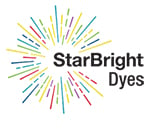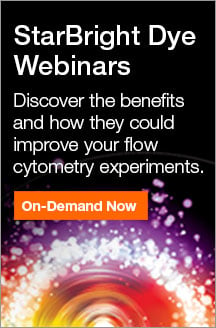StarBright Dye FAQs

- On This Page
- StarBright Dye FAQs
 StarBright Dyes are the new range of bright fluorescent dyes from Bio-Rad
StarBright Dyes are the new range of bright fluorescent dyes from Bio-Rad
To help answer any questions you may have, we have listed some of the common, frequently asked questions with detailed answers to help you incorporate StarBright Dyes effectively in your multicolor flow cytometry experiments.
What is the concentration of antibody for StarBright primary conjugated antibodies?
Unlike conventional fluorescent dyes that have multiple dyes bound per antibody, StarBright™ Dyes have multiple antibodies bound per dye molecule. Calculating the relative amount of antibody in the vial can therefore be misleading when comparing antibody concentration to other conjugated antibodies.
For this reason, we sell StarBright Dye conjugates in 5 μl tests at an in-house optimized concentration. Even though we optimize in-house, we still recommend optimizing and titrating for your experiment.
While the concentration is similar for different lots of each conjugate, the concentration may not be the same between antibodies. The information below will give you the expected range. Contact technical support antibody_tech_uk@bio-rad.com for StarBright Dye concentration or for more information.
For a StarBright Dyes conjugated antibody at 200 µg/ml concentration (measured by concentration of StarBright Dye), the amount of antibody in a standard 100 test vial is 17.5-25 µg and the antibody concentration is 35-50 µg/ml.
What size are StarBright Dyes?
StarBright Dyes range in size from 16-24 nm in size depending upon the StarBright Dye.
Are StarBright Dyes similar to Quantum Dots (QDots)?
QDots are semiconductor nanocrystals around 2-20 nm in size that typically have a cadmium core, plus selenium or tellurium, surrounded by a shell composed of another higher band gap semiconducting material, such as zinc sulfide, which improves the optical properties, protects, and allows processing for conjugation to biomolecules like antibodies. They have high extinction coefficients and quantum yields making them very bright.
Changing the size of quantum dots alters the emission max after excitation. StarBright Dyes are a semiconducting nanomaterial with a similar size to QDots and high extinction coefficients and quantum yields also giving them superior brightness to many fluorescent dyes. However, they have a completely different structure. They are made by copolymerizing subunits of monomers which determine the excitation and emission into a dot, but do not contain any toxic heavy metals and changing the size does not alter the emission maxima.
Are StarBright Dyes tandems?
Technically StarBright Dyes are tandems as they are composed of donor and acceptor molecules which allow energy to be transferred from one dye to another resulting in a longer Stokes shift.
However, unlike other tandem dyes, which are composed of three or more acceptor dyes covalently bonded to a donor molecule, such as PE-Cy5, there is a long chain of donors and acceptors that are collapsed into a dot. This makes the electron transfer very efficient and more structurally stable resulting in less variation in signal and spectra over time.
Are StarBright Dyes compatible with compensation beads in flow cytometry?
StarBright Dyes have been tested on different types of commercially available compensation beads and have been found to be compatible with all those tested. They were successfully used to compensate a 12-color panel. Visit the compensation bead webpage for full details of the testing and a comparison of the results when using cells or beads.
Can StarBright Dyes be used in spectral flow cytometry?
Virtually all fluorescent dyes that can be used in conventional flow cytometry can be used in spectral flow cytometry as long as they are excited by a laser present in the instrument and can be detected within the dynamic range of the detectors. Unlike conventional flow cytometry however, the entire spectral signature is collected rather than separating the emission using dichroic mirrors and band pass filters.
For use in multicolor experiments in spectral flow cytometry, the dye has to also have a unique emission spectrum from other dyes in the panel to enable it to be easily unmixed. Although StarBright Dyes were developed on the ZE5 Cell Analyzer, we have extensively tested them in spectral flow cytometry. To help when building multicolor panels for spectral flow cytometry, similarity scores and examples of multicolor panels are available, and the full spectral traces can be viewed in our spectraviewer.
Can StarBright Dyes be used in intracellular staining in flow cytometry?
StarBright Dye conjugated antibodies are currently only available against cell surface markers and are not currently conjugated to intracellular markers. StarBright Dyes are however compatible with most intracellular staining buffers and do not suffer from loss of performance when used as part of a combined surface and intracellular staining protocol.
We would recommend staining the surface markers, and then fixing and permeabilizing the sample ready for intracellular staining. Detailed protocols for common antibody uses including surface and intracellular staining can be found on our antibody protocols webpage.
Can StarBright Dyes be used in microscopy?
StarBright Dye conjugated primary antibodies are currently only validated in flow cytometry and StarBright Dye secondary antibodies are validated for western blot. With the correct excitation source and detection equipment, the fluorescence emitted from StarBright Dyes after excitation will be detectable in microscopy.
StarBright Dyes are currently being fully evaluated in microscopy to determine the optimal conditions for staining and signal detection, therefore we have not yet validated them for use in this application.
Do we offer isotype controls?
StarBright Dyes are not available conjugated to isotype control antibodies. The appropriate use of isotype controls can be controversial in flow cytometry, but if used correctly they can reveal the levels of unwanted background staining. Isotype controls are recommended to be raised in the same species, be the same isotype, have the same fluorescent dye attached, and be used at the same concentration as the primary antibody.
As mentioned above, StarBright Dye conjugated antibodies are sold as 5 μl test sizes and the concentration in the vial may vary between targets, making matching the concentration difficult. There are other flow cytometry controls that can be performed to ensure reproducible results such as unstained, FMO, single stained, viability, and biological controls.
What are the differences between StarBright Dyes for flow cytometry and western blot?
StarBright Dyes for western blot are only validated for use in western blot, have been conjugated to secondary antibodies, and have been lyophilized, whereas StarBright Dyes for flow cytometry are only validated for flow cytometry, are conjugated to primary antibodies, and are sold as a liquid in 100 test vials.
There are currently only two StarBright Dyes for western blot, which are excitable by a 488 nm excitation source and emit at 520 nm and 700 nm, respectively. In contrast to this, there will be 32 StarBright Dyes for flow cytometry, excitable by 355 nm, 405 nm, 488 nm, 561 nm, and 640 nm excitation sources, emitting from 400-815 nm.
For more general information on antibodies and answers to common questions please visit our general FAQ site.



